February 2019 - I had the pleasure of visiting John and Jane Jeffery to see and try some of the processes involved in making ALPS in their workshop/home in Edinburgh. As well as being wonderful, warm, funny and generous people they also gave me lunch and cake so all in all, a terrific time!
ALPS - WHAT ARE THEY?
ALPS are Antique Lining Papers, they're hand printed decorative papers. The designs are direct copies or inspired by patterns found on or inside old books.

ALPS are primarily made for covering and lining books and boxes but of course can be used in interior design; covering walls and furniture, making lampshades, framing or of course simply keeping and looking at!

An example of ALPS in "action".
This little binding was made by one of our customers, Todd Moe. Todd used a small piece of a single colour block printed paper made on printer's waste for endpapers.
I particularly like this because the pattern works great on a small binding and it demonstrates how to use a material which could be considered by some to be relatively expensive in an efficient way.

The same paper used to cover a large storage box (48 x 31 x 8 cm, 19 x 12 x 3 inches).
WHO MAKES THEM?
These wonderful papers are made in Edinburgh, Scotland by John and Jane Jeffery, an incredibly talented and dedicated husband and wife team.
John is first and foremost a Greek Orthodox priest. When he's not attending to church business he spends his time bookbinding and printmaking.
His wife, Jane, is responsible for drawing and carving the blocks and printing the papers with John.
HOW ARE THEY MADE?
These are made entirely by hand using traditional printmaking techniques, ostensibly block printing and stencils.

An intricately carved block by Jane Jeffery. This took around a month to finish.
THE BASE PAPERS
Prints can be made on any old paper but John and Jane Jeffery choose to use a specific type of old paper - something called printer's waste.
Printer's waste in this instance are pages from antique books which are broken and beyond repair - normally partial books which would otherwise be useless and thrown away. The pages are removed and trimmed and made ready for print thus giving them a new lease of life.
The advantage of using these papers other than the recycling aspect is that the quality of the paper is superb, unmatched today. Made 200 or 300 years ago from linen rag, the underlying print from the pages adds character to something already quite unique.

An close-up look at print over original text. This paper taken from 1642 House of Lords records.

An example of antique printer's waste before being over printed. This was from an incomplete 17th or 18th century German book.

The paper used for this exotic tropical print was made by WS Hodgkinson in Wookey Hole, Somerset, England in the 1930s. This is a handmade imitation parchment paper which typically would have been used for legal documents and in this instance was used as an accounts ledger.

One of the great things about recycling a good used quality paper is that you're giving something used a new life which would otherwise be discarded as imperfect. I think it adds to the story and the charm of the piece.
You'll see some of the prints are made on a coloured background. These have been treated with a colour wash or a broad print before the main printed subject is applied and so quite often the print comprises of the original printed page, a wash or under print and then the final print.

Example of a print on a print on a print. The original print is text on the page. A second orange cloured print is applied and finally blocks of medieval angels in black are applied to complete.
INKS
Before the block is printed the printing ink is made.
This is done by cooking up a wheat starch paste and mixing it with the colour of choice.
Acrylic paint is often used as the base colour, the paste adds a slight translucency and flexibility.
How to make paste
Making paste is very simple.
Pop some strong flour & water in a pan, cook on the hob and continuously stir (never stop) until it goes past the lumpy doughy stage and becomes silky pasty.
Add colour to suit.
However, that said, I'm lazy and I cheat and use premade Japanese Nori paste which is tapioca starch and comes in tubes and tubs. It's a lot more expensive but it's much faster and you don't have to make great piles of wheat paste so it's less wasteful if you're only experimenting with small amounts.
PRINTING BLOCKS
The first step is to draw and carve the design on lino blocks. These can either be large blocks with a simple repeat pattern or a combination of very small blocks used in combination to create intricate patterns. The most intricate blocks can take up to a month to carve.
The block below is quite large and simple. It allows a pattern to be printed relatively quickly with one or two impressions.

A hand carved lino block with a simple repeat pattern of flowers or florets within diamond shapes.

Detail of the repeat pattern carved into the lino block.
An example of the repeat printed pattern using the block illustrated above. This block has been used to print this two colour green and yellow print.
The first colour print is applied using two impressions to cover the sheet of paper and when dry, the second colour is applied.
One of the important skills demonstrated here is called registration which means lining up the blocks so that the two prints are lined up and not incorrectly overlapping.
BRONZE VARNISH
Occasionally we have Bronze Varnish papers to sell of to make products.

These bindings have covered in a Bronze Varnish paper. The base paper in this instance is a plain, modern printmaking paper coloured with a wash of paste ink and the pattern applied using a large lino block. This was then over stencilled in black to pick out the flowers.
Bronze Varnish refers to the ink used. It's similar to the paste inks but instead of adding paint or ink to colour we add bronze powder which is exactly as it sounds - powdered bronze metal.

The process is simple enough. The bronze varnish is applied to the lino printing block with a roller.

Here we see John Jeffery using a roller brayer to transfer the bronze varnish from the block to the paper.

The bronze varnish over printed onto a paste paper.
Another, extremely time consuming technique employed is printing repeat patterns using multiple small blocks.

In the photo above you can see how this pattern is made using a small rectangular block for the black print and a circular block to apply the red highlight. Imagine how long it takes and how much concentration is required to make a large sheet of this!
Multiple Use
The beauty of using blocks is that they can be used in a variety of ways from printing a very simple single colour pattern to creating a vivid, beautiful multiple colour print.

This pigeon block is one of my favourites.

John Jeffery in his workshop applying paste ink to the pigeon block

John Jeffery printing using the pigeon block.

The same block was used to create this print. The colours (pink, yellow, blue and orange) have been applied using stencils.
STENCILS
Adding highlighted colours to prints can be carried out using a series of stencils.

This photograph shows a stencil, the printing block and finished print. The print is made of three colours.
The black is the base print made using black paste ink and printed directly from the block.

A full size block. This intricate carving takes around a month to complete.
The pink and blue colour highlights are then made by laying a stencil over the print, applying the first colour and when dry the second stencil is laid over the print and the second colour applied which gives a three colour print; black, pink and blue.

The finished print - three colours. The black applied directly from the block and the blue and pink applied using two stencils.

A print made using individual blocks. The blue has already been applied using a stencil.

Stencil in position over the print.

Jane Jeffery applying red paste ink through the stencil onto the print.

The finished article. Multiple stencils used to apply colour to a base print.
MINIATURE BLOCKS AND STENCILS
As if all of these processes isn't laborious enough to impress, check this out...

A sheet of paper made up of tiny repeat pattern prints.

Each tiny print is printed in black and then stenciled over in blue, red and yellow.

The block for each tiny print measures about 4 x 2 1/2 cm or 1 1/2 x 1 inch.
BUYING ALPS
Here at VPCo we hold stock of about 80 ALPS at any one time.
They are priced according to complexity - single colour, two colours or more than two colours. As you will understand from the piece above, a three colour print is essentially three prints on one paper. Finishing one sheet is quite a time consuming process.
The standard range of ALPS are available on a BUY 2 GET 1 FREE offer.
Simply add 3 papers to your cart and the least expensive paper will automatically be discounted by special robots here at VPCo.
You can see and purchase these beautifully printed papers here.
SPECIAL ORDERS
You can also order any of the patterns in virtually any colour combination subject to a minimum order quantity and of course the papers can also be printed on various papers other than antique printers waste if required.
Please be aware that this is quite a slow process, likely to take many weeks.
To discuss this please feel free to contact us at info@vintagepaper.co.uk

A sample book of ALPS gifted to me by the Jefferys at Christmas time. It contains a whole stack of beautiful hand printed paper. I am VERY lucky.
Hope you enjoyed this piece. Feel free to leave comments.
Thank you.
William
Owner, Vintage Paper Co.




WOW! I just received the paper that I ordered from your company and am so inspired to get going on making things from them. I craft handmade cards and matchboxes among other things. Thank you for including the different processes .I did lino block making and printing in school and although it’s been a long time I’m going to try it again.I really appreciate the work that goes into paper making and printing ,and your company makes such incredible pieces that I had a hard time choosing what to order , so I ordered a lot! The people that I give my items to are so appreciative and it makes me feel great to share them.Im so grateful that I found you…..
Thank you so much for posting this blog. I had not heard of these remarkable artist craftspeople before and am completely blown away by their talent and dedication. As a Linocut artist myself I’m in awe of the skills they demonstrate in cutting their patterns so neatly and accurately, whilst maintaining the original spontaneity of the design. Superb
Brilliant piece William! I have just had another look at the papers I got from you a few weeks ago and I appreciate the work in them so much more now.
Thanks so much for sharing this knowledge and photo-documentation. Very generous of you all! I’m attending a Madeleine Durham workshop this weekend so the wheels are REALLY turning now.
All this is simply marvellous! Thank you for sharing, I’ve been making decorative papers with many techniques (including these) for a long time, but the quality here is outstanding! Love them!
Leave a comment